Jiaxin Huang
Efficient Medical Image Restoration via Reliability Guided Learning in Frequency Domain
Apr 15, 2025Abstract:Medical image restoration tasks aim to recover high-quality images from degraded observations, exhibiting emergent desires in many clinical scenarios, such as low-dose CT image denoising, MRI super-resolution, and MRI artifact removal. Despite the success achieved by existing deep learning-based restoration methods with sophisticated modules, they struggle with rendering computationally-efficient reconstruction results. Moreover, they usually ignore the reliability of the restoration results, which is much more urgent in medical systems. To alleviate these issues, we present LRformer, a Lightweight Transformer-based method via Reliability-guided learning in the frequency domain. Specifically, inspired by the uncertainty quantification in Bayesian neural networks (BNNs), we develop a Reliable Lesion-Semantic Prior Producer (RLPP). RLPP leverages Monte Carlo (MC) estimators with stochastic sampling operations to generate sufficiently-reliable priors by performing multiple inferences on the foundational medical image segmentation model, MedSAM. Additionally, instead of directly incorporating the priors in the spatial domain, we decompose the cross-attention (CA) mechanism into real symmetric and imaginary anti-symmetric parts via fast Fourier transform (FFT), resulting in the design of the Guided Frequency Cross-Attention (GFCA) solver. By leveraging the conjugated symmetric property of FFT, GFCA reduces the computational complexity of naive CA by nearly half. Extensive experimental results in various tasks demonstrate the superiority of the proposed LRformer in both effectiveness and efficiency.
Vivid4D: Improving 4D Reconstruction from Monocular Video by Video Inpainting
Apr 15, 2025Abstract:Reconstructing 4D dynamic scenes from casually captured monocular videos is valuable but highly challenging, as each timestamp is observed from a single viewpoint. We introduce Vivid4D, a novel approach that enhances 4D monocular video synthesis by augmenting observation views - synthesizing multi-view videos from a monocular input. Unlike existing methods that either solely leverage geometric priors for supervision or use generative priors while overlooking geometry, we integrate both. This reformulates view augmentation as a video inpainting task, where observed views are warped into new viewpoints based on monocular depth priors. To achieve this, we train a video inpainting model on unposed web videos with synthetically generated masks that mimic warping occlusions, ensuring spatially and temporally consistent completion of missing regions. To further mitigate inaccuracies in monocular depth priors, we introduce an iterative view augmentation strategy and a robust reconstruction loss. Experiments demonstrate that our method effectively improves monocular 4D scene reconstruction and completion.
CrossWordBench: Evaluating the Reasoning Capabilities of LLMs and LVLMs with Controllable Puzzle Generation
Mar 30, 2025Abstract:Existing reasoning evaluation frameworks for Large Language Models (LLMs) and Large Vision-Language Models (LVLMs) predominantly either assess text-based reasoning or vision-language understanding capabilities, with limited dynamic interplay between textual and visual constraints. To address this limitation, we introduce CrossWordBench, a benchmark designed to evaluate the reasoning capabilities of both LLMs and LVLMs through the medium of crossword puzzles-a task requiring multimodal adherence to semantic constraints from text-based clues and intersectional constraints from visual grid structures. CrossWordBench leverages a controllable puzzle generation framework that produces puzzles in multiple formats (text and image) and offers different evaluation strategies ranging from direct puzzle solving to interactive modes. Our extensive evaluation of over 20 models reveals that reasoning LLMs outperform non-reasoning models substantially by effectively leveraging crossing-letter constraints. We further demonstrate that LVLMs struggle with the task, showing a strong correlation between their puzzle-solving performance and grid-parsing accuracy. Our findings offer insights into the limitations of the reasoning capabilities of current LLMs and LVLMs, and provide an effective approach for creating multimodal constrained tasks for future evaluations.
EVolSplat: Efficient Volume-based Gaussian Splatting for Urban View Synthesis
Mar 26, 2025Abstract:Novel view synthesis of urban scenes is essential for autonomous driving-related applications.Existing NeRF and 3DGS-based methods show promising results in achieving photorealistic renderings but require slow, per-scene optimization. We introduce EVolSplat, an efficient 3D Gaussian Splatting model for urban scenes that works in a feed-forward manner. Unlike existing feed-forward, pixel-aligned 3DGS methods, which often suffer from issues like multi-view inconsistencies and duplicated content, our approach predicts 3D Gaussians across multiple frames within a unified volume using a 3D convolutional network. This is achieved by initializing 3D Gaussians with noisy depth predictions, and then refining their geometric properties in 3D space and predicting color based on 2D textures. Our model also handles distant views and the sky with a flexible hemisphere background model. This enables us to perform fast, feed-forward reconstruction while achieving real-time rendering. Experimental evaluations on the KITTI-360 and Waymo datasets show that our method achieves state-of-the-art quality compared to existing feed-forward 3DGS- and NeRF-based methods.
Urban4D: Semantic-Guided 4D Gaussian Splatting for Urban Scene Reconstruction
Dec 04, 2024Abstract:Reconstructing dynamic urban scenes presents significant challenges due to their intrinsic geometric structures and spatiotemporal dynamics. Existing methods that attempt to model dynamic urban scenes without leveraging priors on potentially moving regions often produce suboptimal results. Meanwhile, approaches based on manual 3D annotations yield improved reconstruction quality but are impractical due to labor-intensive labeling. In this paper, we revisit the potential of 2D semantic maps for classifying dynamic and static Gaussians and integrating spatial and temporal dimensions for urban scene representation. We introduce Urban4D, a novel framework that employs a semantic-guided decomposition strategy inspired by advances in deep 2D semantic map generation. Our approach distinguishes potentially dynamic objects through reliable semantic Gaussians. To explicitly model dynamic objects, we propose an intuitive and effective 4D Gaussian splatting (4DGS) representation that aggregates temporal information through learnable time embeddings for each Gaussian, predicting their deformations at desired timestamps using a multilayer perceptron (MLP). For more accurate static reconstruction, we also design a k-nearest neighbor (KNN)-based consistency regularization to handle the ground surface due to its low-texture characteristic. Extensive experiments on real-world datasets demonstrate that Urban4D not only achieves comparable or better quality than previous state-of-the-art methods but also effectively captures dynamic objects while maintaining high visual fidelity for static elements.
Divide, Reweight, and Conquer: A Logit Arithmetic Approach for In-Context Learning
Oct 14, 2024
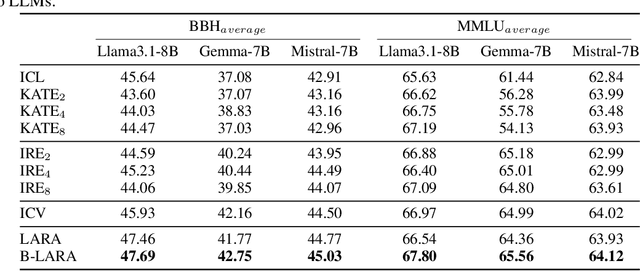
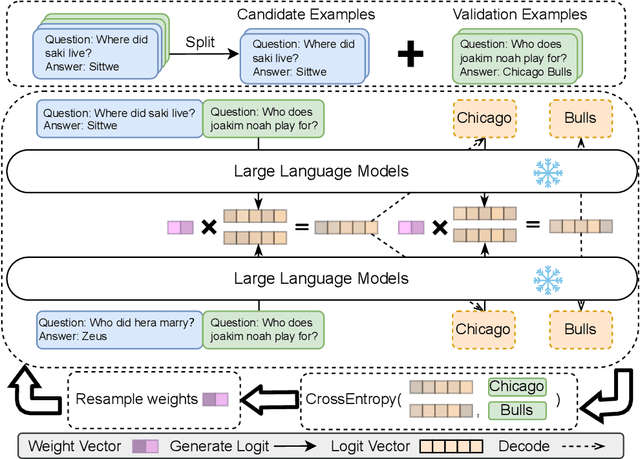
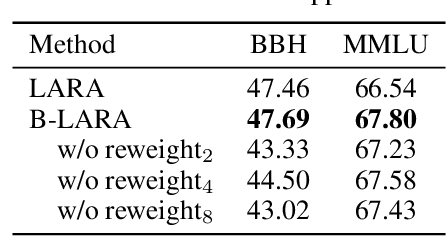
Abstract:In-Context Learning (ICL) emerges as a key feature for Large Language Models (LLMs), allowing them to adapt to new tasks by leveraging task-specific examples without updating model parameters. However, ICL faces challenges with increasing numbers of examples due to performance degradation and quadratic computational costs. In this paper, we propose Logit Arithmetic Reweighting Approach (LARA), a novel framework that enhances ICL by using logit-based ensembling of multiple demonstrations. Our approach divides long input demonstrations into parallelizable shorter inputs to significantly reduce memory requirements, and then effectively aggregate the information by reweighting logits of each group via a non-gradient optimization approach. We further introduce Binary LARA (B-LARA), a variant that constrains weights to binary values to simplify the search space and reduces memory usage by filtering out less informative demonstration groups. Experiments on BBH and MMLU demonstrate that LARA and B-LARA outperform all baseline methods in both accuracy and memory efficiency. We also conduct extensive analysis to show that LARA generalizes well to scenarios of varying numbers of examples from limited to many-shot demonstrations.
Taming Overconfidence in LLMs: Reward Calibration in RLHF
Oct 13, 2024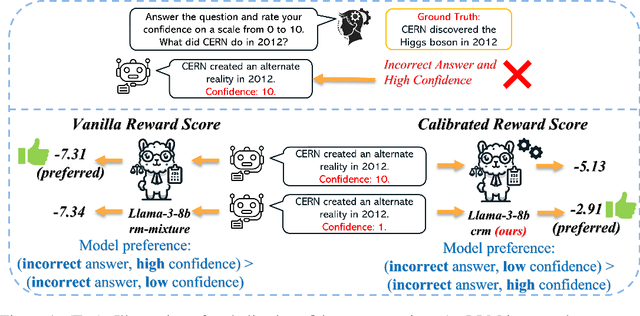
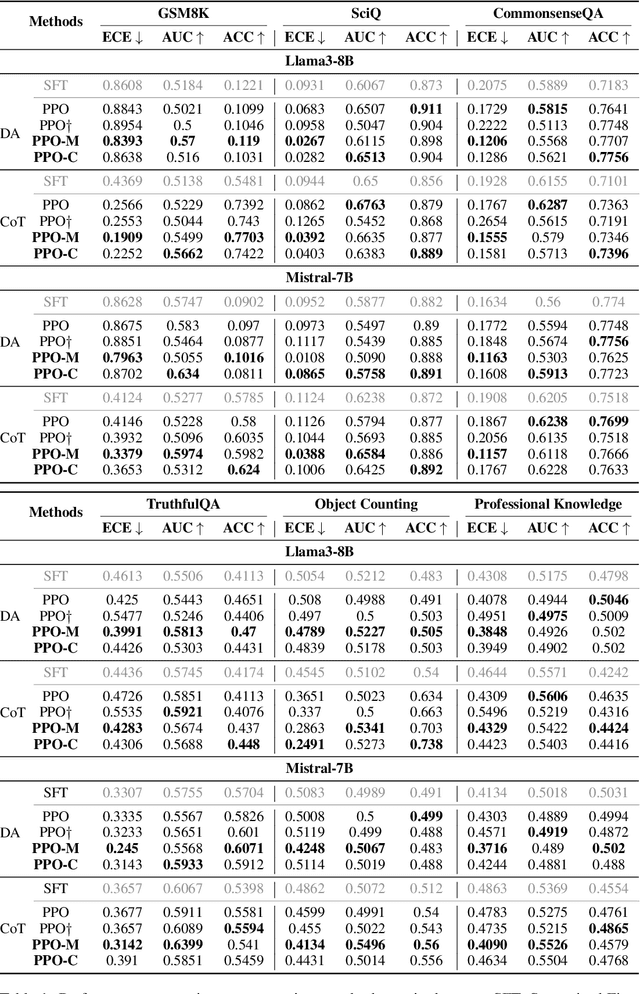
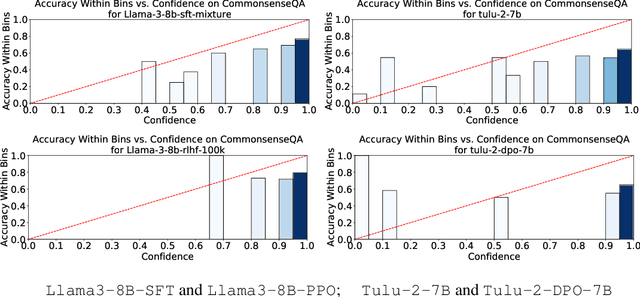
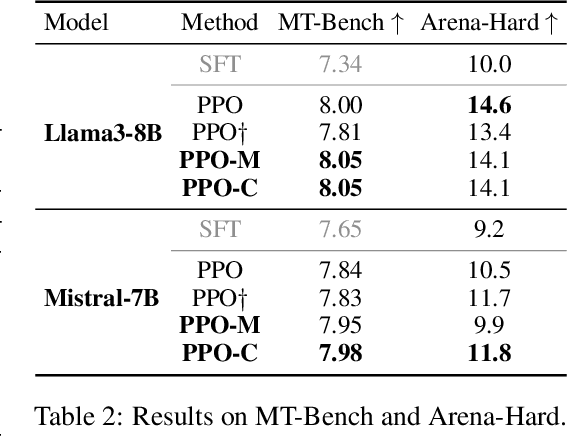
Abstract:Language model calibration refers to the alignment between the confidence of the model and the actual performance of its responses. While previous studies point out the overconfidence phenomenon in Large Language Models (LLMs) and show that LLMs trained with Reinforcement Learning from Human Feedback (RLHF) are overconfident with a more sharpened output probability, in this study, we reveal that RLHF tends to lead models to express verbalized overconfidence in their own responses. We investigate the underlying cause of this overconfidence and demonstrate that reward models used for Proximal Policy Optimization (PPO) exhibit inherent biases towards high-confidence scores regardless of the actual quality of responses. Building upon this insight, we propose two PPO variants: PPO-M: PPO with Calibrated Reward Modeling and PPO-C: PPO with Calibrated Reward Calculation. PPO-M integrates explicit confidence scores in reward model training, which calibrates reward models to better capture the alignment between response quality and verbalized confidence. PPO-C adjusts the reward score during PPO based on the difference between the current reward and the moving average of past rewards. Both PPO-M and PPO-C can be seamlessly integrated into the current PPO pipeline and do not require additional golden labels. We evaluate our methods on both Llama3-8B and Mistral-7B across six diverse datasets including multiple-choice and open-ended generation. Experiment results demonstrate that both of our methods can reduce calibration error and maintain performance comparable to standard PPO. We further show that they do not compromise model capabilities in open-ended conversation settings.
Efficient Depth-Guided Urban View Synthesis
Jul 17, 2024



Abstract:Recent advances in implicit scene representation enable high-fidelity street view novel view synthesis. However, existing methods optimize a neural radiance field for each scene, relying heavily on dense training images and extensive computation resources. To mitigate this shortcoming, we introduce a new method called Efficient Depth-Guided Urban View Synthesis (EDUS) for fast feed-forward inference and efficient per-scene fine-tuning. Different from prior generalizable methods that infer geometry based on feature matching, EDUS leverages noisy predicted geometric priors as guidance to enable generalizable urban view synthesis from sparse input images. The geometric priors allow us to apply our generalizable model directly in the 3D space, gaining robustness across various sparsity levels. Through comprehensive experiments on the KITTI-360 and Waymo datasets, we demonstrate promising generalization abilities on novel street scenes. Moreover, our results indicate that EDUS achieves state-of-the-art performance in sparse view settings when combined with fast test-time optimization.
GOFA: A Generative One-For-All Model for Joint Graph Language Modeling
Jul 12, 2024



Abstract:Foundation models, such as Large Language Models (LLMs) or Large Vision Models (LVMs), have emerged as one of the most powerful tools in the respective fields. However, unlike text and image data, graph data do not have a definitive structure, posing great challenges to developing a Graph Foundation Model (GFM). For example, current attempts at designing general graph models either transform graph data into a language format for LLM-based prediction or still train a GNN model with LLM as an assistant. The former can handle unlimited tasks, while the latter captures graph structure much better -- yet, no existing work can achieve both simultaneously. In this paper, we identify three key desirable properties of a GFM: self-supervised pretraining, fluidity in tasks, and graph awareness. To account for these properties, we extend the conventional language modeling to the graph domain and propose a novel generative graph language model GOFA to solve the problem. The model interleaves randomly initialized GNN layers into a frozen pre-trained LLM so that the semantic and structural modeling abilities are organically combined. GOFA is pre-trained on newly proposed graph-level next-word prediction, question-answering, and structural tasks to obtain the above GFM properties. The pre-trained model is further fine-tuned on downstream tasks to obtain task-solving ability. The fine-tuned model is evaluated on various downstream tasks, demonstrating a strong ability to solve structural and contextual problems in zero-shot scenarios. The code is available at https://github.com/JiaruiFeng/GOFA.
Optimizing Language Model's Reasoning Abilities with Weak Supervision
May 07, 2024



Abstract:While Large Language Models (LLMs) have demonstrated proficiency in handling complex queries, much of the past work has depended on extensively annotated datasets by human experts. However, this reliance on fully-supervised annotations poses scalability challenges, particularly as models and data requirements grow. To mitigate this, we explore the potential of enhancing LLMs' reasoning abilities with minimal human supervision. In this work, we introduce self-reinforcement, which begins with Supervised Fine-Tuning (SFT) of the model using a small collection of annotated questions. Then it iteratively improves LLMs by learning from the differences in responses from the SFT and unfinetuned models on unlabeled questions. Our approach provides an efficient approach without relying heavily on extensive human-annotated explanations. However, current reasoning benchmarks typically only include golden-reference answers or rationales. Therefore, we present \textsc{PuzzleBen}, a weakly supervised benchmark that comprises 25,147 complex questions, answers, and human-generated rationales across various domains, such as brainteasers, puzzles, riddles, parajumbles, and critical reasoning tasks. A unique aspect of our dataset is the inclusion of 10,000 unannotated questions, enabling us to explore utilizing fewer supersized data to boost LLMs' inference capabilities. Our experiments underscore the significance of \textsc{PuzzleBen}, as well as the effectiveness of our methodology as a promising direction in future endeavors. Our dataset and code will be published soon on \texttt{Anonymity Link}.
 Add to Chrome
Add to Chrome Add to Firefox
Add to Firefox Add to Edge
Add to Edge